Barberry Thunberg "Darts red lady": description, planting, care and reproduction
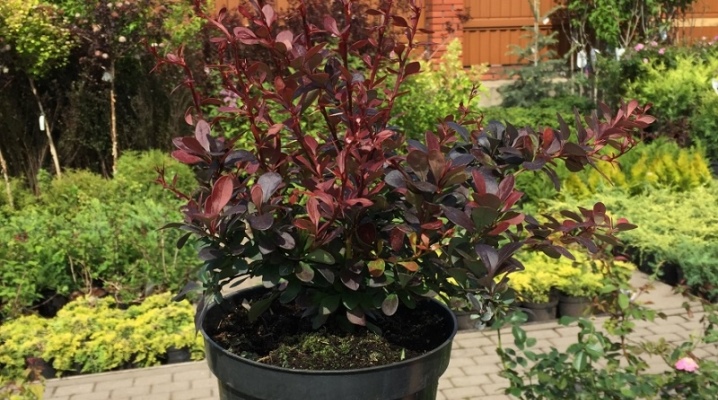
The variety of barberry Thunberg, which received the name "Darts Red Lady", is an ornamental plant that has gained its popularity due to the amazing property of the leaves. They change their color throughout the season. The culture of this variety tolerates low temperatures well and is resistant to diseases.

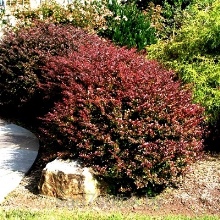
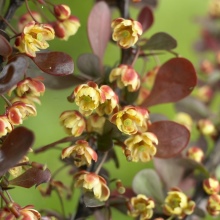
Description
The natural habitat of the ornamental deciduous shrub of the Thunberg barberry is the Far East. The plant is also found in North America and parts of Europe. In Russia, the shrub is widespread and is often used for the improvement of garden and park areas. Due to its frost resistance, it is possible to grow "Darts red lady" in the cold regions of our country. The botanical description of the cultivar is as follows.
- The wide crown of the shrub has a rounded shape. In its size, it can reach 1.5 meters.
- The height of an adult plant can range from 1 to 1.5 meters.
- The growth rate of the shrub is average, up to 10 centimeters per year.
- The trunk and shoots of the barberry are covered with needle-like bunches.
- The arched branches of the plant are ribbed, young shrubs are pale red in color. The branches of an adult barberry take on a rich brown color.
- The buds on the bushes of this variety are presented in the shape of an egg, painted in a pale red hue.
- On the petioles of barberry there are small rounded leaves, they are painted in purple. In autumn, the color of the leaves turns fiery red.
- Flowering begins at the end of spring, in the second half of May. The inflorescences have a faint aroma, are painted in a pale yellow color, and are covered with red stripes on top.
- Red fruits appear in autumn and cover the shoots of the shrub before spring.
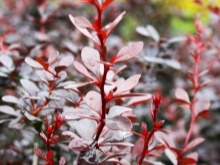
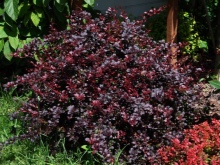
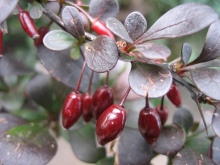
Planting and leaving
The success of growing barberry directly depends on the correct planting of the plant and its subsequent care. First you need to prepare a planting site and a seedling. The variety of barberry Thunberg "Darts Red Lady" is recommended to be grown in well-lit areas. The site should also be sheltered from strong winds. It is possible to form a hedge from barberry. Loamy soil is the most favorable for growing shrubs. The heavy soil is sprinkled with river sand. The plant does not like excess moisture.
For planting, you must choose only healthy seedlings.
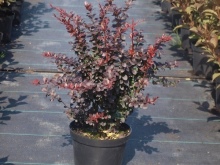

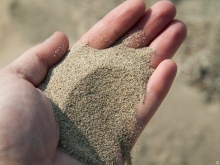
The rules for planting a shrub variety "Darts Red Lady" are as follows.
- Planting is carried out in the spring.
- On the prepared site, planting holes are made half a meter deep, the gap between the seedlings should be at least 1.5 meters.
- The bottom must be covered with drainage.
- The planting pit is filled with a substrate that you can prepare yourself from humus, sand and fertile soil.
- After filling the hole with earth, you need to leave a place for at least 3 weeks until the soil has completely shrunk.
- Before planting barberry, the hole is covered with soil so that the seat takes on the appearance of a hill. A seedling is planted on top.
- After compacting the soil, the plant must be watered.
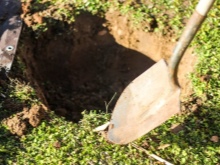

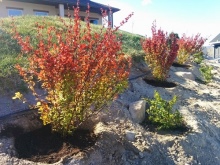
Watering the barberry should be done only in drought conditions, at normal times the plant has enough moisture due to precipitation. Around the bush, you need to pour a thin layer of humus and pour warm water under the root. From time to time you need to loosen the soil and clear the area of weeds. The Darts Red Lady barberry variety has a good response to fertilizers.You need to feed the plant immediately during planting. Periodically, the plant is fertilized with organic matter. In the autumn season, it is advisable to dig up the soil under the bush and fertilize the plant with compost.
The crown of the shrub is formed largely due to pruning. Barberry is cut in the spring, sometimes in the fall, after the foliage has fallen. Weak and frost-damaged shoots are removed. A young plant needs to be pruned every year, and once every six months is enough for an adult.
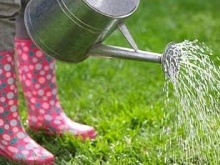
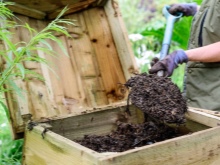
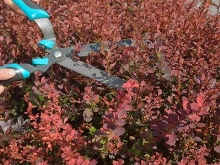
The culture tolerates low temperatures well. Sometimes shoots freeze, they must be cut off with the onset of heat.
To play it safe and protect the barberry from the cold, preparation must begin in November. The ground around the plant is watered with warm water. The moistened soil almost does not freeze, thereby protecting the root system. Then the soil is mulched. Humus can be used as mulch. A frame is placed around the plant, on which the shelter is attached. Polyethylene is not suitable as a covering material.

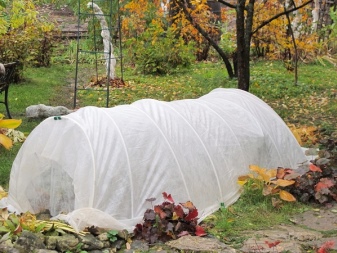
Reproduction
There are several ways of breeding Barberry Thunberg "Darts Red Lady", among them there are such.
- Cuttings. The barberry shoots are cut, the length of which should be 15 centimeters. For this purpose, both green branches and lignified planting material are suitable. It is recommended to immerse the shoots in the growth stimulant solution for a while before planting. Then the cuttings are planted in small containers, after rooting of the shoots, they can be transplanted into open ground.
- Reproduction by layering. This process takes place in the spring. It is enough to choose the strongest and longest branch, then fix it with staples and cover it with earth. The cuttings need feeding and regular watering. In the fall, it is separated from the mother bush and transplanted.
- Reproduction by dividing the bush. This method is great for transplanting barberry. The root should be divided into several parts, and then treated with a special material. Coal is usually used. Shrubs can be propagated in this way both in spring and autumn.
- Reproduction using seeds. The most difficult way to propagate a shrub. In the fall, when the fruits are ripe, the seeds are harvested. The shell of the planting material is cut and planted in the ground. The first shoots appear in spring. After 2 years, barberry seedlings are transplanted into open ground. Seed germination does not exceed 40%.
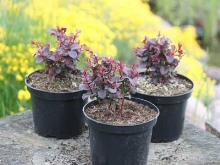
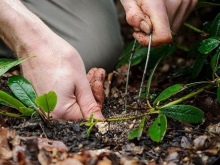
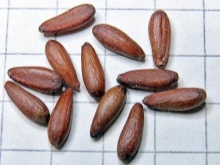
Diseases and pests
Barberry variety "Darts red lady" has a high degree of resistance to various diseases and harmful insects. Stagnant moisture can provoke the appearance of fungus.
- Spotting. Black spots appear on the leaves, after which wilting is observed. To combat spotting, the bush is sprayed with a solution of copper oxychloride.
- Powdery mildew. The shoots and leaves of the bush are covered with a white bloom. Colloidal sulfur will be an effective medicine against this fungal disease.
- Rust. The leaf plate is completely covered with orange spots. Fungal spores are firmly entrenched on the back of the leaf. The disease develops quickly enough, therefore, requires an immediate solution. To avoid wilting, the barberry shrub is sprayed with Bordeaux liquid.

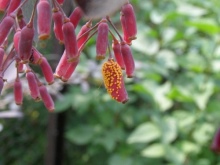
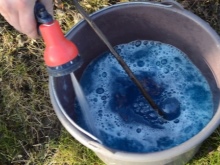
Among pests, moth and aphids are considered especially dangerous, the first feeds on the fruits of barberry, and the second on its juice. With such an influence, the development of the plant slows down significantly. To get rid of, use insecticides.
The bush can also be sprayed with tobacco dust infusion.
In the next video you will find additional information about the Thunberg barberry "Darts Red Lady".



































































The comment was sent successfully.